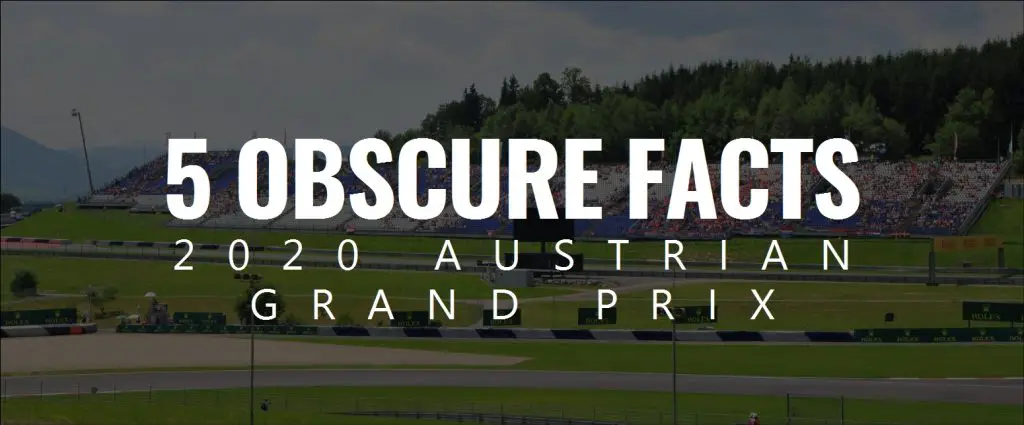Identical lap times, uncharted territory for Vettel and a new podium combination. Here are five of the most obscure facts and statistics from the 2020 Austrian Grand Prix weekend!
A new podium combination
Between them, Mercedes, Ferrari and McLaren have had 1,470 podium finishes in Formula 1. That’s 48% of all the possible podium positions in F1’s World Championship history. All three teams rank within the top four constructors with the most podium appearances. Yet remarkably, the 2020 Austrian Grand Prix marked the very first time that these three teams have finished on the podium together. While Ferrari and Mercedes have shared countless podiums in recent years, there has never been a podium result made up of one Mercedes driver, one Ferrari driver and one McLaren driver.
The last time Mercedes and McLaren shared a podium result was at the 2014 Australian Grand Prix, when Nico Rosberg won for the German manufacturer and Kevin Magnussen and Jenson Button finished second and third for McLaren. The last time that Ferrari and McLaren shared a podium was at the 2012 Brazilian Grand Prix – the scene of Button’s last Formula 1 win, where he was joined on the rostrum by Ferrari’s Fernando Alonso and Felipe Massa.
Identical lap times
There were three strange coincidences over the 2020 Austrian Grand Prix weekend regarding lap times. Firstly, in Free Practice 3, Lewis Hamilton topped the timesheet with a 1:04.130 – which was the exact same time as he set in the same session over the 2019 Austrian Grand Prix weekend. Secondly, in the final part of qualifying, Alex Albon and Sergio Perez set identical lap times (1:03.868) for fifth on the grid. Albon was awarded the higher position as he set the lap time first. Thirdly, Lando Norris set the fastest lap of the 2020 Austrian Grand Prix – a 1:07.475. That lap time is the exact same time with which Max Verstappen set the fastest lap of the race at the Red Bull Ring last year.
The 1-7-3 combination
This is the sixth Formula 1 race in history in which the polesitter won the race, the driver starting seventh finished second and the driver starting third finished third. The 1-7-3 podium combination has happened previously at the 1966 Dutch Grand Prix, 1984 German Grand Prix, 1988 Hungarian Grand Prix, 1995 Spanish Grand Prix and 2003 British Grand Prix.
The most recent time that the drivers starting first, third and seventh on the grid finished on the podium in any order was at the 2016 European Grand Prix. In that race, polesitter Nico Rosberg won, Sebastian Vettel finished second having started third on the grid and Sergio Perez finished second having started from seventh.
The 1975 French Grand Prix, 1998 Monaco Grand Prix, 2000 Italian Grand Prix, 2010 European Grand Prix, 2016 Monaco Grand Prix and 2016 Canadian Grand Prix are the only other races in which the drivers starting from the first, third and seventh grid slots have all appeared on the podium.
First tenth place finish for Vettel

Sebastian Vettel finished in uncharted territory at the 2020 Austrian Grand Prix. For the first time in his 241 race career, Vettel finished in tenth position. Prior to this weekend, tenth, fourteenth and twentieth were the only positions in the top twenty in which Vettel had never finished.
Jackie Stewart, Mika Hakkinen, Mike Hawthorn, Nigel Mansell and Niki Lauda are the other World Champions to have had a single tenth place finish in their careers. Like Vettel, Lauda’s only tenth place finish came at the Austrian Grand Prix.
Vettel’s tenth place this weekend was the 100th tenth place finish for a driver on the 2020 grid. Meanwhile, Williams’ George Russell and Nicholas Latifi are now the only drivers on the current grid to have never finished in tenth place.
For the first time since 1981, 1975 and 1958…
Valtteri Bottas led every lap on his way to victory at the 2020 Austrian Grand Prix. It’s the first time that Bottas has held the lead from lights to flag in his Formula 1 career. It was also only the fourth lights to flag victory in Austrian Grand Prix history – and the first time that anyone has achieved the feat in Austria since Jacques Laffite at the 1981 event. Talking of long periods of time since anyone achieved feats in Austria, Lando Norris became the first driver to record the first Fastest Lap of his career in Austria since Vittorio Brambilla did so on his way to victory at the 1975 Austrian Grand Prix.
Meanwhile, Valtteri Bottas won with a 2.700 second margin over Charles Lelcerc. The last time a race win was decided by 2.7 seconds was all the way back in 1958, when Stirling Moss won the season-opening Argentine Grand Prix with a 2.7 second advantage over Luigi Musso. Of course, it’s worth noting that the timing system ran to only one decimal place in those days.
And for a more recent case of history repeating itself – Bottas took pole position for the 2020 Austrian Grand Prix by 0.012 seconds. It’s the smallest pole margin ever seen at the Austrian Grand Prix, and the equal-30th smallest pole margin in Formula 1 history. The last time pole was decided by 0.012 seconds was just three races ago, when Bottas pipped his Mercedes team-mate to pole position for the 2019 United States Grand Prix!
Want more Formula 1 statistics? Check out our full run down of all the statistics from the 2020 Austrian Grand Prix weekend!

